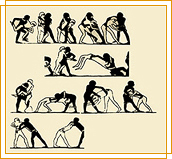Egypt and Mesopotamia
Athletics and the spirit of competition sprang in the Mediterranean long before the Olympic games became an institution in Greece in
the 8th century BC.  A number of literary and iconographic sources
from Egypt and Mesopotamia, dating approximately from 3000 BC and
on, indicate the existence of athletic activities. A number of literary and iconographic sources
from Egypt and Mesopotamia, dating approximately from 3000 BC and
on, indicate the existence of athletic activities.
Egypt and Mesopotamia did have regular sport meetings, in some of which, even food was granted to the athletes. However, there is hardly any evidence that the aim of these contests was the recognition of outstanding individuals.
The pharaohs of Egypt and the kings of Mesopotamia have recorded their interest in athletic activities on the walls of their temples and tombs. Sports in Egypt included wrestling, stick fighting, boxing, acrobatics, archery, equestrian events, boat-rowing and ball games. The oldest reliefs with wrestling scenes, dated from the 2400 BC, decorated the tombs of Ptahotep and Ahethotep.
At Beni Hasan more than 4000 wrestling scenes were found, dated from 2000 BC. There, a number of athletic movements and postures of athletes in pairs are depicted. The wrestlers, wearing belts, attempt to turn their opponents to their backs. In a relief in the Temple of Ramses III at Madinet Habou, dating from the 12th century BC, Egyptians and foreigners are seen competing in wrestling and stick-fighting in front of the pharaoh. There is a scene of the proclamation of the winner, another one that depicts the intervention of an officer and finally one in which an Egyptian wrestler applies a choking neckhold to his opponent and then celebrates his victory. The scene is bearing an inscription with the warning: "Beware! The Pharaoh is near."
Wrestling scenes were also popular in Mesopotamia. Wrestling scenes carved on seals and reliefs of all periods depict wrestlers wearing belts and grabbing their opponents from theirs'. Cuneiform texts from Mesopotamia refer to different postures and holds on the limbs and belt. According to one view, belt wrestling was an essential part of a warrior's or hero's life. In the known epic of Gilgamesh, the divine hero meets Enkidou in a wrestling match, whereby they seized each other like trained wrestlers.
It is most likely that athletic festivals were limited to the royal court and that the athletic activities were mainly the concern of the members of the upper classes. Egyptian texts reveal the importance of physical training for the pharaoh and the members of his court. We are, thus, informed that Tuthmosis' III impressive and numerous achievements in archery fulfill the wish of his followers. There is also a reference to the king of Mesopotamia who has demonstrated his hunting aptitude before his nobles. An inscription referring to pharaoh Amenophis II described how he challenged other nobles in archery. Furthermore, the stone from Giza boasts that "that was a deed that had never been done before... except in the case of the King who is rich in glory."
|
